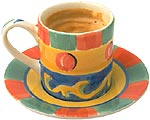Solar Micro Car Kit DIY STEM Kit
$9.99$5.95
 It would seem that it should not matter whether you poured the cream into the
coffee or the coffee into the cream. The final temperature in either case should
be same.
It would seem that it should not matter whether you poured the cream into the
coffee or the coffee into the cream. The final temperature in either case should
be same.
 'My scientific work is motivated by an irresistible longing to understand the secrets of nature and by no other feelings.'
'My scientific work is motivated by an irresistible longing to understand the secrets of nature and by no other feelings.'